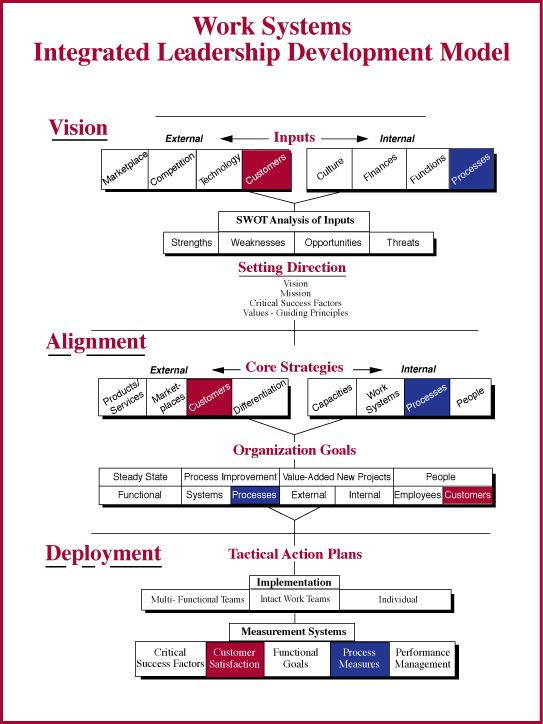Team Development - The Executive Team |
||
Team Articles:
|
Section Two: The Executive Team
|
|
This series of documents focuses on Executive Team Development and provides a set of proven concepts and development methodologies useful to any organization that is trying to improving the performance of their executive team. |
||
Main content below |
||
The Integrated Leadership Model
Effective functioning in the core components of leadership (Vision - Alignment - Deployment) is an essential responsibility of the Executive Team. This requires a well defined system (see example below) for defining excellence in these areas and for achieving traction in creating substantial strategic improvement in the competitiveness of the organization.

We now take a look at how the Top Management ability to function as a team affects the effectiveness of leadership in these three areas.
Setting Vision - a Team Effort
The first role of a leadership team is establishing a vision. Vision includes defining the core purpose for the organization, and setting the direction by which the firm will position itself both for the external marketplace and for the work force.
The vision must be both broad and specific. Broad enough to encompass the hopes, dreams and desires for the future in a way that captures the emotional appeal of a knowledge-based work force. Specific enough for individuals to develop the definition and scope of their own work areas in the fulfillment of that vision.
For a vision to be accepted and embraced by the work force it must clearly embody the spirit and words of the executive team. It is essential that the message from top management be consistent and unanimous. Dissension at the senior levels creates confusion and even competing behavior at other levels of the organization.
The creation and acceptance of this vision must first be the team effort of top management. Individual executives cannot submit “their pieces” and wait for the CEO to pull it all together. The vision must be developed by all, and embraced by each. In short, top management must function as an executive team throughout the process to both create the vision, and communicate their collective endorsement of that vision through words and actions.
Generating Alignment
Top Management First, Organization-wide Second
Alignment is the process by which the vision is translated into strategic direction, specific goals, and business processes that are understood and fully accepted at all levels of the organization.
This too must be an integrated effort. The shift from a functional organization to a cross-functional process-driven organization requires a different way of thinking. Executives must be willing to “let go” of traditional power bases called functions or departments and begin instead to take ownership of core cross-functional processes.
But in this definition functional owners become process owners through a critical shift in meaning. To “own” is to “serve.” Processes are defined by the needs and requirements of the customers of the process. Suppliers and users of the process are involved in its continuous improvement. Here, traditional applications of decision-making, authority, and control - which were the lifeblood of functional ownership - will doom any real attempts at continuous improvement.
Goals must be based on the overarching strategic direction of the firm, rather than the individual functional goals that have traditionally been used to set budgets and allocate resources. All resources must be aligned to achieve the goals and strategic direction of the firm, not to protect any individual power bases or special interests.
This process of aligning the entire firm along several core goals is potentially the most powerful role that top management can play. When an organization is fully aligned, all the systems are working in concert with each other to achieve the common goals. Success is defined by such criteria as customer satisfaction, market share, growth, profitability, and other factors that define the overall health and success of a business. Individual functional requirements are subordinated to the alignment created through these higher level goals.
In order for top management to align themselves and then the entire firm, they must first work together to determine the strategic goals and direction for the firm. Those factors critical to the success of the firm’s common goals are then defined. From this point, core processes and owners of these processes can be determined. Then goals at other levels of the organization can be identified.
Clearly this is work that can only be accomplished by a team that is working together, applying its best collective thinking to the process. Any efforts by individuals to “protect their turf” will sub-optimize the whole.
Alignment, therefore, requires a top performing executive team whose primary focus is to set and then achieve the overall goals of the firm.
Guiding Deployment
Empowering People to Take Action
Deployment is the third core responsibility of leadership. It is the act of ensuring that the most appropriate resources are placed in the optimal place at the key point in time where they can have their maximum effect. Deployment was originally a military term used to describe how all resources - men, material, artillery, etc. are to be used to engage and win the war. Deployment is based on the premise that a force does not have to establish overall dominance and superior strength to win a war. It suffices to have the critical advantage at the point of engagement.
This analogy can be brought directly to companies and the marketplace. Contracts are won one at a time. Customers are satisfied one at a time. “Moments of truth” occur thousand fold, but each is its own event.
Deployment must be precise, administered at the moment and point of engagement, and applied with maximum effectiveness to achieve the desired impact.
Optimal deployment decisions are made at two levels. The first of these levels is strategic. Forces must be in the right military theater or business environment for them to have the possibility of an impact. They must have the resources and supply lines to be used effectively. And, the purpose of their use must be known and accepted implicitly by all - the act of prior alignment.
Once engaged, it is the field commander who must have the flexibility of use - along with the knowledge and skill - to adjust these forces in the heat of the battle. The generals who are studying the field from afar or learning of it only through reports are not in the best position to make the tactical decisions of the moment - even if their decisions are right they are certainly not timely. Once the strategic deployment has been made, it is the job of the generals to trust their field command to use and modify these resources as they see fit based on the circumstances of the moment.
This analogy can be applied directly to business. At the highest level it is the top management who must make the strategic decisions regarding the deployment of resources. Which markets to attack; which products to develop; which geographic regions to support; which initiatives to fund; how to apply all the resources collectively to gain the maximum impact is clearly their collective responsibility. And this must be executed as a collective responsibility. If each top manager “fights” for his resources, then it is only the CEO who can make the overall decisions - which puts the full risk of the firm on a single mind. If the entire top management is functioning as an integrated team, it will apply its collective thinking to the problem. The deployment of resources is then determined by what is the best application of resources, not who most successfully argued for the biggest piece of the pie.
This is the strategic element of deployment by top management.
The second element of top management’s role in deployment is to allow its field command - those closest to the customer - to adjust and apply these resources most appropriately to meet the needs of customers and the marketplace, thereby gaining competitive advantage.
In the traditional hierarchical organization, decisions are pushed up to the level of authority where they can be resolved. In the team-based environment, these same decisions are pushed down to the individuals closest to the customer where the most directly applicable knowledge can be applied to the situation.
Managers guide; they do not control. Top managers coach; they do not command. Feedback is heard and acted upon; the messenger is not killed. Adjustments are made by the individuals dealing directly with the customer or those directly serving them; orders are not sent down from above. Employees are expected to apply initiative and take risks to serve the customers and the company; not follow blindly or execute orders that they know to be inappropriate.
In this second role of deployment, managers must do more than delegate. They must fully empower the work force to act. They must set the vision; ensure alignment; train their work force; and then let go and trust.
Controls are contained in clarity of vision; full alignment is generated through clearly articulated goals; behaviors are driven through common values and guiding principles; and feedback is measured against known measures identified through the firm’s critical success factors.
This is the true impact of a team-based environment - it appears to have little controls because the controls are internal and known and accepted by all. This allows for a level of flexibility and responsiveness that cannot even be imagined by a traditional, hierarchical, command and control organization.
The case for team-based organizations led by top management teams is compelling. The following documents describe the characteristics of such a team at the executive level, and provide the guidelines and steps for establishing them.
The following documents describe the team issues that need to be addressed to build the executive team so they can be more effective at creating vision, building an aligned organization and ensuring deployment happens throughout the enterprise.
NEXT "Section Three: Issues Addressed in Developing the Top Team"
